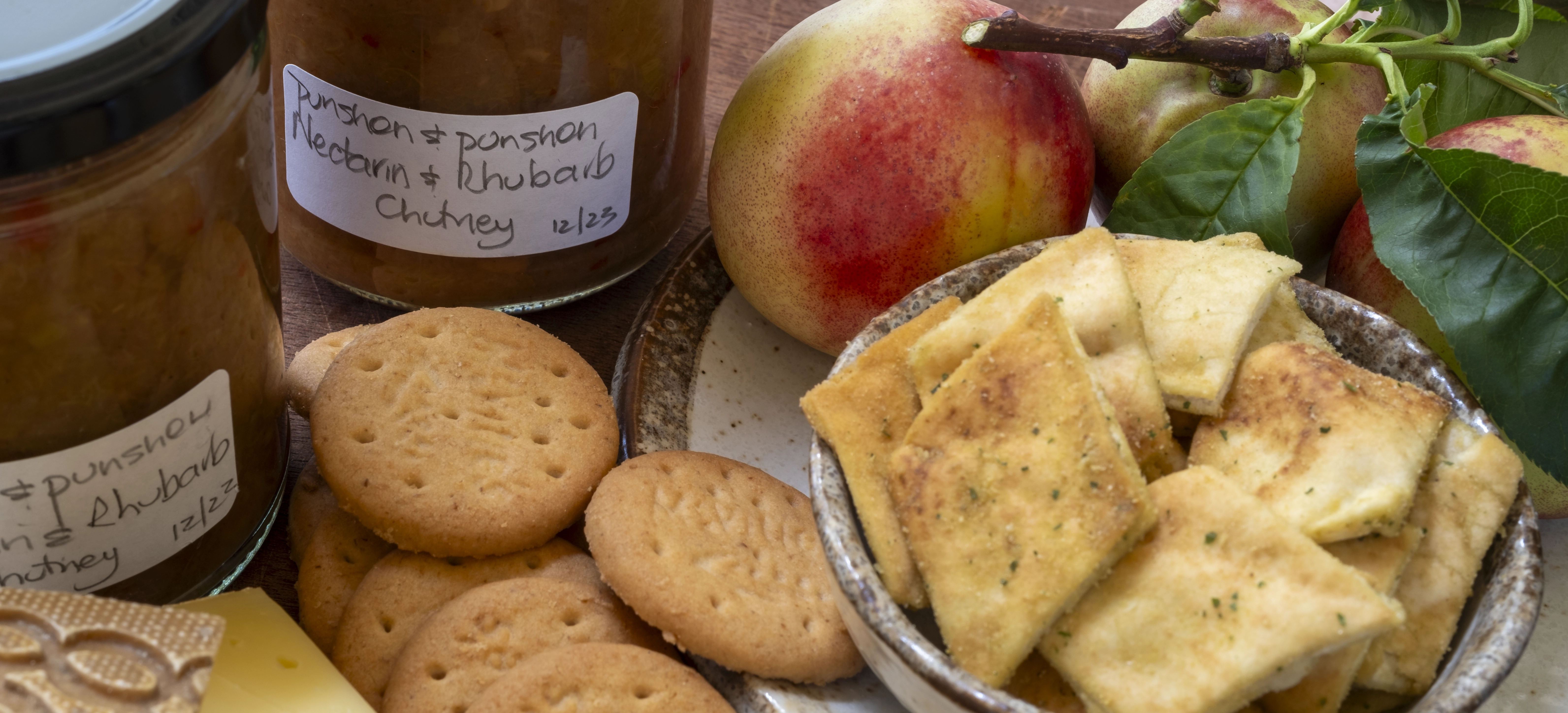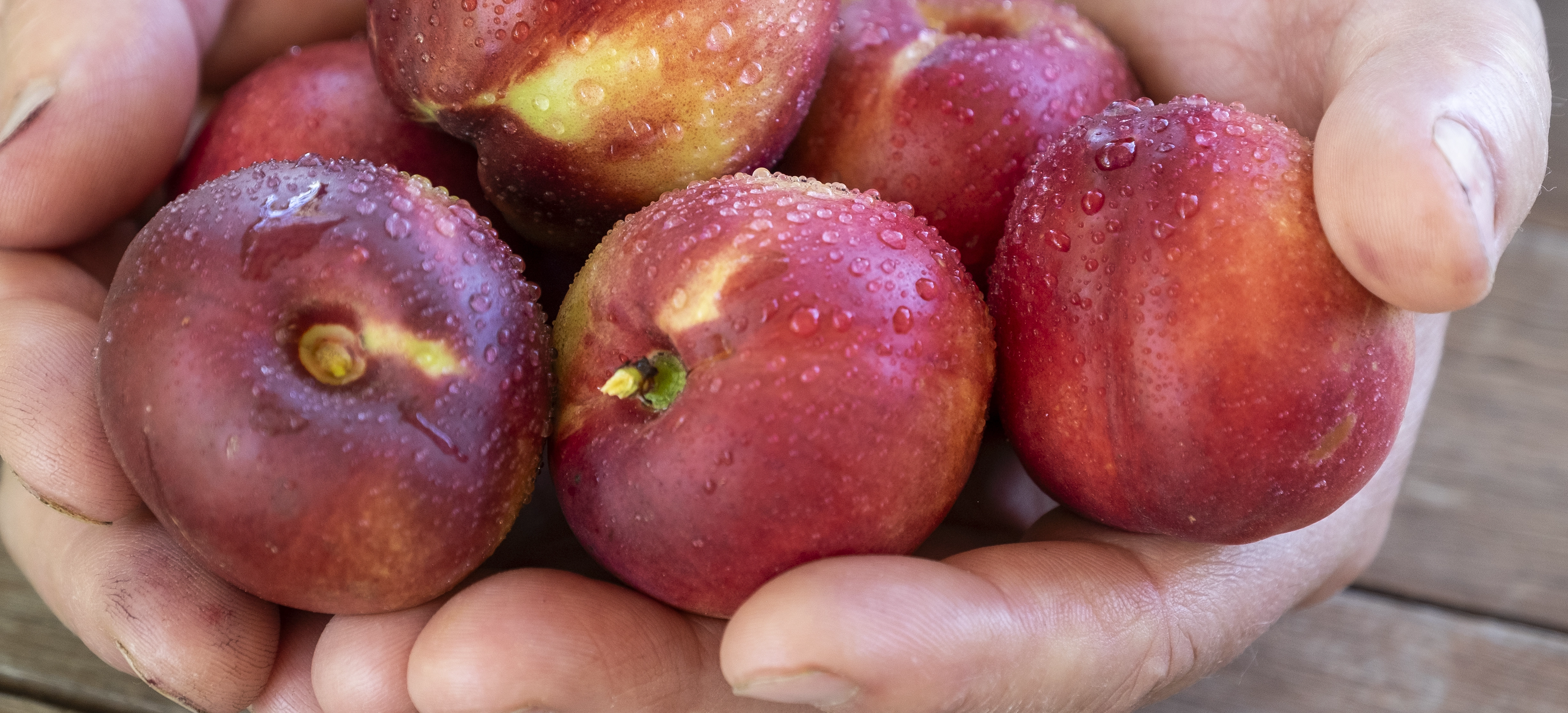Nectarine and Rhubarb Chutney
- Pickles, Chutney, Relish & Sauces

Yellow nectarines and ruby red rhubarb make a perfect team in this summertime chutney. While the nectarines are sweet and juicy team it up with some fruity rhubarb and enjoy this chutney throughout the year. Enjoy with smoked meats and seafood, hard and soft cheeses, curries, potted meats and terrines, savoury pancake stacks and veggie burgers. And make sure it’s set on the BBQ table as a fruity alternative to the traditional BBQ accompaniments.
- Preparation Time:
- 30 minutes
- Cooking Time:
- 30 minutes
- Quantity:
- 5 x 200 ml
PREPARATION
Sterilise good quality sealable jars and protective lining lids

INGREDIENTS
- 400ml
- Apple cider vinegar
- 300g
- White sugar
- 680g
- Yellow nectarine
- 320g
- Ruhbarb, stalks
- 1
- Brown onion, medium
- 5
- Garlic cloves, fresh
- 5 cm
- Ginger, fresh
- 1
- Red chilli
- 1 teaspoon
- Salt
METHOD
Peel, stone and cut the nectarines into large chunky pieces. If the stone fruit is ripe, the skin will easily peel away. If assistance is required, use a vegetable peeler. Wash and dry the rhubarb to remove any excess moisture. Removed the leaf and root ends and discard. Cut into 5-8 cm (2inches) pieces.
Peel and finely chop the onions and garlic, peel and grate the ginger. Cut the chilli in half and finely chop. If you want a milder chilli heat to the chutney, remove the seeds with a teaspoon and discard. Refer to the Notes Section: Handling Chillies below.
In a large stainless steel preserving pan or heavy bottom stainless steel pot, add the prepared nectarine, rhubarb, onions, chilli, ginger, garlic, vinegar, salt, and sugar.
Heat gently, stirring occasionally until the sugar is completely dissolved.
Bring the mixture to the boil, then reduce the heat and simmer for approximately 30 minutes until the fruit has softened and it has thickened. To test the chutney is cooked to the right consistency, spoon a little of the mixture on to a plate. The chutney should hold its shape. If the mixtures becomes too dry and requires further cooking to soften the fruit add a small amount of water.
Stir the mixture frequently to prevent the fruit from sticking to the bottom of the pan.
Use a funnel to pour the hot cooked chutney into hot dry sterilised screw cap sealable jars. Fill to approximately 2.5cm (1 inch) from the top of the jar and seal. Cool and label and store in a cool dark place in the kitchen or pantry.
Allow the chutney to mature for at least 3weeks before eating.
NOTES
- Choose clean ripe fruit. Do not use overripe and never use mouldy fruit as this will produce a poor-quality chutney.
- If the nectarines are medium ripe the skin will peel off easily. Use the same technique used to peel a banana. Discard the skin. You can leave the skin on but there will be pieces of cooked skin throughout the chutney. It is edible but will not look as elegant as a chutney where the skin has been removed.
- Cutting the fruit approximately the same size produces a more evenly cooked chutney consistency. Cut the fruit larger if you like a chunkier style, or for a smoother texture, cut the fruit into smaller pieces.
- The cooking time is an approximation only. Cooking time will depend upon:
- The size of preserving pan - the broader the pan the quicker the evaporation
- Degree of fruit ripeness – the riper the fruit, the sweeter and juicer the initial chutney will be The degree of heat when cooking – the higher the heat, the greater the boil which will produce greater evaporation.
- Handling chillies
- It is important to wash your hands thoroughly after handling and de-seeding chillies. Chilli oil is easily transferred from the chillies to hands. If you touch your eyes or any delicate areas, the chilli oil will be transferred on contact and create a burning sensation.
- Types of sugar & vinegar
- The type and colour of the sugar and vinegar used will affect the final colour and flavour of the chutney. Malt vinegar and brown sugar will produce very dark brownish red chutney with a more earthy/molasses background flavour, while white wine or apple cider vinegar and white sugar will produce chutney that has a fresher and brighter flavour. This is a matter of personal choice.
- Take care to only use vinegar which has a 5% minimum acetic acid content. The acetic acid content acts as the principal preservative, and any lower quantity will compromise the safety of your preserves. Commercially available vinegar is 5%, however most homemade vinegars do not achieve this level. For this recipe I have specifically chosen white sugar and apple cider vinegar to retain a fresh bright coloured chutney.
- To test the chutney is cooked to the right consistency, spoon a little of the mixture on to a plate. The chutney should hold its shape and all the fruit and onion should be cooked
- Towards the end of the cooking process, it may be necessary to stir regularly. It is important that the fruit does not stick to the bottom of the pan and burn. Your chutney will be tainted with a burnt flavour and is not very pleasant.
- Good quality jars should be used in all preserving, particularly when they are processed in a hot water bath. Thin jars often cannot withstand the temperatures and may crack either in the bath or on and or after removal. Avoid the disappointment and invest in some good jars from a homewares or preserves outlet. Select jars that have non-reactive lids as the vinegar solution can cause the lids to rust over time.
- Ginger (Zingiber officinale)
- Ginger has a hot-spice, citrusy woody taste. It’s available as a fresh underground stem, botanically known as a rhizome, or as a finely ground powder. The dried version is used in baking and spice blends whereas fresh ginger is used widely in Asian cuisine. Do not substitute dried ginger for fresh as the dried form has a stronger and more aromatic flavour. When purchasing fresh ginger, avoid older rhizomes with signs of shrivelling as the plant is drying out and the flesh can be fibrous.
- Peaches and Nectarines: Clingstone, freestone, white or yellow – what’s the difference.
- Peaches and nectarines are classified as a stone fruit as their ripe luscious fruit surrounds a central pip which further encases its seed. While both will soften after harvest, they will not ripen and further develop their sweetness and colour. For a full flavour, sweet, luscious, flavoured peach, or nectarine, pick when ripe straight from the tree or purchase at a local farmers market or farm-gate stand.
- They are either a freestone or clingstone variety and have either a white or yellow flesh. The clingstone has a stone/pip which clings to the fruit and is not easily removed. As the stone is not edible, the fruit flesh has to be eaten or cut away. Whereas the stone is easily removed from the fruit in the freestone variety.
- White peaches and nectarines have a more delicate flavour and a floral sweetness. The flesh is also delicate and easily bruised. It is best eaten fresh as when its cooked it tends to become mushy, and its flavour is easily overpowered by the other ingredients. The yellow peach has a more intense flavour, has a sturdier flesh and is more suitable for cooking and preserving.
- What’s the difference between a relish and chutney? A relish is usually made with fruits that are cut into smaller pieces, more frequently made with white or cider vinegar, generally made with a lower proportion of vinegar and sugar and cooked for a shorter time. This results in a lighter flavour with a fresher, crisper consistency
